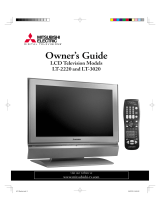
Remote Control
Overview
Figure 1,next page
1. Slide Switch: SeIects the A/V product to be controlIed
by the remote control. Select TV for NetCommand@
device control.
2. Numbers: IndividuaiIy select channels or enter
information into menus.
3. SQV {SuperQuickViewTM}: Scans through memorized
lists of favorite channels.
4. CN(ANNEL}/PAGE: Scans up or down through
memorized channels. Pages up and down through
screens when used with TV Guide On Screen@,
ChanneiView TM, a satellite receiver, some cabie boxes,
memory card piayIists and JPEG thumbnails. Skips
through DVD chapters.
5. DEVICE: Dispiays the Device Seiection menu in which
you can select the device to view (ANT-1 and ANT-2, TV
Disc, or devices connected to the TV's inputs, including
IEEE 1394 devices).
6. ADJUST: Press _ V 4 [_ to navigate menus, change
settings, and move the PIP on-screen Iocation.
Operates many NetCommand@ functions. Navigate TV
Guide On Screen@ and change settings. Performs skip
forward and backward functions during TV Pause.
7. TvMENU:Displaysthe VimP01111'on-screenmenu
system.
8. ENTER: Selects a channei number or menu item.
9. DEVICE MENU: Dispiaysthe menu for devices
connected to the TV, inciuding CableCARD TM. For VCR
or DVDs, press once to display' the transport menu,
press again to dispIay the VCR or DVD menu. Displays
and removes options menus for TV Guide On Screen.
Opens the Media Dialog Box for memory cards.
10. INFO: Press to display an on-screen summary of the
current device used and any broadcast information
available (including current V-Chip information). See
chapter 6 for detaiIs on the on-screen display.
WhiIe in TV Guide On Screen, press repeatedly to cycle
through the available info box sizes.
Press twice to display' the TV Pause slider when this
feature is active.
11.V-CHIP: Turns the V-Chip Lock on or off.
12. PIP/POP: Turns on PIP and cycles through PIP and
POP display' choices.
13. PIP OH: ScroIIs up or down through memorized
channels for PIP
14. PIP DEVICE: Displays PIP Selection menu to seIect the
PIP or POP image source device
15. REC {Record}: Displays the Record menu for setting
up recordings to TV Disc or other recordabIe device.
Sets up recordings while in ChanneiView or the TV
Guide On Screen Listings screen. Records with a VCR.
16. REW/REV: Reverse scans in TV Pause or TimeShuttle.
Rewinds a VCR. Reverse scans TV Disc, DVD,A/V Disc,
or memory card file.
17. POWER: Turns power on and off for the TV and other
A/V products.
18. QV {QuickViewTM}: Switches between the current
channeI and Iast channei viewed.
19. SUB/CANCEL: For digital channels, adds separator
between main and sub-channei numbers. CIears SQV
and some menu entries, and canceis recordings.
20. VOLUME: Changes sound Ievei.
21. MUTE: Turns sound off or back on.
22. GUIDE: Press to display or remove TV Guide On
Screen or ChanneiView for ANT-1 and 2. Displays
Track List for TV Disc and A/V Disc. Displays program
guide for sateiIite receiver, or DVD Disc menu. Displays
thumbnails or pIaylists for memory card flies.
23. Light: Located on the right side of the remote control,
this feature iIIuminates buttons or Iabeis.
24. HOME: Exits TV on-screen menus dispiays; exits the
TV Guide On Screen system and returns to TV viewing.
25. AUDIO: Selects individuai audio settings for
adjustment.
26. VIDEO: Selects individual video settings for adjustment.
27. EXCN: Exchanges PIPor POP and main TV picture.
28. SLEEP: Sets the TV to turn off within 2 hours. See the
next page for setup instructions.
29 CONNECT: Initiates EEE 1394 peer-to-peer
connections.
30. FORMAT: Changes the shape and size of the main TV
picture.
31. PAUSE: With TV Pause enabled (with the Always
or On Request option), pauses program viewing and
activates TV Pause to atIow forward/backward scans
in a broadcast program (when no PIP/POP image is
displayed). Returns to TV viewing from TV Pause. With
TV Pause disabled (Off), operates as standard pause
by freezing a broadcast TV picture (when no PIP/POP
image is displayed). When MP/POP is displayed,
freezes that image. Pauses TV Disc, a VCR, DVD,A/V
Disc, or memory card file playback.
32. PLAY: Plays the TV Disc, a VCR, DVD, A/V Disc, or
memory card file.
33. FF/FWD: Forward scans in TV Pause. Fast forwards
a VCR. Forward scans TV Disc, DVD, A/V Disc, or
memory card file.
34. STOP: Stops pIay of the TV Disc, a VCR, DVD, A/V Disc,
or memory card file.
16 Chapter 1. Television Overview




















